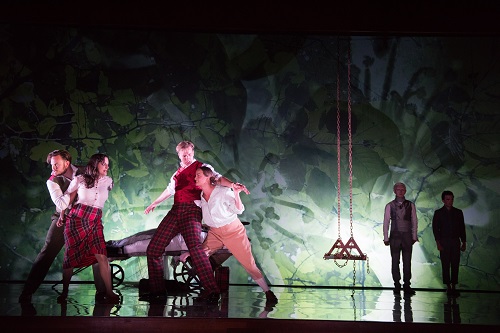 United Kingdom Aldeburgh Festival 2017 [1} – Britten, A Midsummer Night’s Dream: Soloists, Aldeburgh Festival Orchestra / Ryan Wigglesworth (conductor), The Concert Hall, Snape Maltings, Suffolk 12.6.2017. (MH)
United Kingdom Aldeburgh Festival 2017 [1} – Britten, A Midsummer Night’s Dream: Soloists, Aldeburgh Festival Orchestra / Ryan Wigglesworth (conductor), The Concert Hall, Snape Maltings, Suffolk 12.6.2017. (MH)

Cast included:
Oberon – Iestyn Davies
Tytania – Sophie Bevan
Puck – Jack Lansbury
Theseus – Clive Bayley
Hippolyta – Leah-Marian Jones
Lysander – Nick Pritchard
Demetrius – George Humphreys
Hermia – Clare Presland
Helena – Eleanor Dennis
Bottom – Matthew Rose
Quince – Andrew Shore
Production:
Director – Netia Jones
Designer, Projection – Netia Jones
Lighting Designer – Ian Scott
A Midsummer Night’s Dream was an appropriate choice for a musical celebration on the anniversary of the Snape Maltings Concert Hall which was opened 50 years ago, in 1967. Renowned for its vibrant acoustic, in which I have had the pleasure of performing, something was amiss with this production. The director, Netia Jones, had chosen to use a half depth stage and erect a false proscenium arch with a back and front lit Cyc for scenic effects projection. The only permanent feature was a swing hung from the flies and various draped chains. Clearly the intention was in homage to the past industrial usage of the building and also nature as presented by the Bard. The ever changing visual effects on the cyc expressed the text and set the mood, even occasionally cleverly hiding several of the fairy characters. However, it did compete for attention with the action which was being presented downstage.
From the opening other worldly rumblings of the strings, the orchestra was in fine form. Britten paints a scintillating orchestral sound-scape. The timbral colours produced throughout the orchestra excited whilst not destroying a fine instrumental balance and texture. In common with Wagner’s Parsifal, written with the composer’s knowledge of the Bayreuth Festspielhaus acoustic, Britten’s Midsummer Night’s Dream would have been perfect for the new Maltings concert hall when it opened, being known to the composer. It was unexpected then, that there was an obvious imbalance of sound between stage and pit for the majority of Act I. So much so, that the opening sequence of fairies and principals, even when singing facing downstage, was barely audible despite their obvious commitment. This improved slightly in Act II and was better again by Act III. The varying lushness of the orchestration and the use of a false proscenium arch with the cyc could have been responsible for this. Had nobody listened?
The mystical opening sequence included an excellent troupe of young treble voices from Chelmsford Cathedral. This band of fairies appeared to be a hybrid between Village of the damned and top-hatted vampires in grey school uniform. Their singing, though inaudible at first, later exhibited a number of excellent strong, young voices. Their fairy choreography of standing in straight lines with occasional marching, was well drilled, though unexpectedly static for a fay regiment.
An excellent Puck, Jack Lansbury, was an agile imp. Notably, he was able to time his acrobatic tumbles to be complete by the exact beat where he had dialogue to deliver; some feat. He also exhibited a pleasing singing voice when mimicking the lost mortals in the wood.
Iestyn Davies (Oberon) was master of all he surveyed. His crystal clear countertenor and commanding presence made a fine, noble match for Sophie Bevan’s Tytania. Her powerful, lyric soprano soared through Britten’s ravishing lines. The royal couple’s silvery grey presence gave us a mystical other world pairing.
The lovers – Lysander (Nick Pritchard), Hermia (Clare Presland), Demetrius (George Humphreys) and Helena (Eleanor Dennis) – were also well matched vocally. Each singer showed clearly defined characterisation in the frenzied world Shakespeare planted them in. A pleasing set of cameos, especially from a travel weary Presland with her cheeky winks and come hither looks.
The crowd pleasers of the play and opera are the Mechanicals. From the first arrival of Bottom (Matthew Rose) on his bicycle, followed by the other tradesmen under the guidance of Quince (Andrew Shore), the audience were treated to simple tomfoolery set to music. Eating and singing at the same time was a questionable characterisation for Snug (Sion Goronwy), which he carried off with aplomb. Whilst Snout (Nicholas Sharratt) and Starveling (Simon Butteriss) showed off their terpsichorial skills in the Bergomask after The Play. Matthew Rose was the voice most able to ride the orchestra and acoustic, with excellent diction and vocal colour, his portrayal of Nick Bottom was just right.
Clive Bayley (Theseus) and Leah-Marian Jones (Hippolyta) completed the earthly ensemble, overseeing the final act with vocal assurance and stature.
The orchestral playing of the Aldeburgh Festival Orchestra under the baton of Ryan Wigglesworth was both expansive and expressive as required, a tribute to Britten and his concert hall.
Netia Jones’s direction, design and projection had interesting touches, paying homage to the history of the hall with the use of Industrial trappings and also suggesting a Suffolk woodland setting. The technical imagery of colour for mortals and silver grey for the fairy realm was also a pleasing concept. As if planned by magic, the moon even appeared over the Maltings during the second interval, together with a passing barn owl for extra effect. How appropriate! Unfortunately there were times when the basic staging was less apt and the attention lavished on the technical presentation was at the expense of the performers. The ever-moving visual display dominated this Britten masterpiece to such an extent that a newcomer to the opera or play may have been hard pressed to follow the story. Sad, with such an excellent cast of singers and orchestra on board.
The Seventieth Aldeburgh Festival of Music and the Arts continues until 25 June 2017.
Martyn Harrison